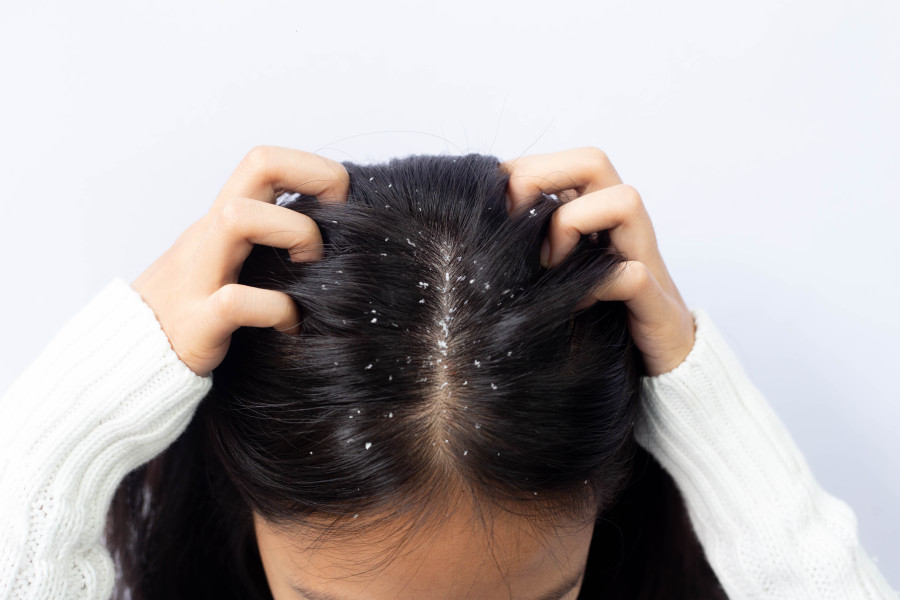Culture & Lifestyle
Combating winter dandruff
Dr Ram Gyan Yadav, a consultant dermatologist, discusses the causes, symptoms, and prevention strategies of the condition.
Anish Ghimire
Many people struggle with dandruff during the winter months. This condition can occasionally be linked to seborrhoeic dermatitis (winter dandruff). Changes in temperature and dry air can cause changes in the normal balance of the skin, especially the scalp. This change in the seasons frequently results in a condition called winter dandruff, which is characterised by irritation, flaking, and itching.
Dermatologist Dr Ram Gyan Yadav provides further insights into the condition. Yadav is a Consultant Dermatologist affiliated with the Madhesh Institute of Health Sciences in Janakpurdham, Madhesh Province. He holds an MD in Dermatology & STDs, having completed his academic qualifications at BP Koirala Institute of Health Sciences (BPKIHS) in Dharan.
Is winter-related dandruff a real phenomenon?
Yes, winter-related dandruff, also known as seborrheic dermatitis, is indeed a genuine occurrence. Dandruff, or seborrheic dermatitis, is a common condition that often occurs in the harsh winter months. This is primarily attributed to the disruption of the skin’s barrier function caused by the combination of low temperatures and low humidity.
What causes dandruff to flare up in colder seasons?
If seborrhoeic dermatitis is the underlying cause of your dandruff, the disease may worsen throughout the winter months. Living in a dry climate is frequently associated with this irritation, which is more noticeable in the winter. During this season, using interior heating systems tends to remove moisture from the air, which worsens seborrhoeic dermatitis and increases the symptoms of dandruff.
How can individuals care for their skin during the winter to prevent dandruff?
Begin by refraining from using hot water for washing your hair and scalp, as it strips away natural oils, exacerbating dryness. Utilise an antifungal shampoo twice a week during your hair-wash routine. When applying conditioner, focus on the hair ends up to the midlength, avoiding direct application to the scalp.
For individuals with seborrheic dermatitis, living in a dry environment during winter can exacerbate dandruff; hence, it’s crucial to maintain adequate humidity levels indoors. Installing a humidifier is an effective measure to counterbalance the moisture-sapping effects of indoor heating. Managing stress is equally essential, as anxiety can contribute to seborrheic dermatitis flare-ups and worsen dandruff. Embrace stress-relieving activities like yoga, meditation, music therapy, regular exercise, and ensuring adequate sleep.
Enhance your diet with anti-inflammatory and antifungal foods, including green tea, garlic, and omega-3-rich options like freshwater fishes, walnuts, avocadoes, flaxseeds, and chia seeds. Incorporate immune-boosting probiotics and vitamin C-rich foods such as citrus fruits and berries. Lastly, avoid excessive use of hair products and exposure to dust and dirt—contributing factors that can aggravate dandruff during the winter months.
Are there specific products or remedies dermatologists recommend for winter dandruff?
The first thing individuals with dandruff need to do is use an antifungal shampoo, fortified with potent ingredients such as ketoconazole and zinc pyrithione. They are highly effective when used twice weekly. Their antifungal properties address dandruff’s underlying causes, helping to alleviate symptoms and restore scalp health.
In cases where dandruff persists despite regular shampoo use, one may incorporate other solutions, such as specialised antifungal and anti-inflammatory lotions and creams, which offer an additional layer of targeted treatment. These topical formulations provide a more comprehensive approach, addressing persistent dandruff that may not be fully controlled by shampoo alone.
For severe and recalcitrant cases of winter dandruff, dermatologists advocate systemic therapy. This involves using oral antifungal medications and vitamin A derivatives, providing a more intensive and systemic approach to address the underlying causes of dandruff. This is reserved for cases where topical solutions may not be sufficient, offering a more robust strategy to manage and alleviate severe and persistent winter dandruff.
Is there a difference in the approach to treating dandruff in winter compared to other seasons?
In treating dandruff, the approach remains consistent throughout the year. Regardless of the season, key practices like regular shampooing, using anti-dandruff shampoos and maintaining good scalp hygiene are effective. However, it’s essential to consider individual variations in skin and hair care needs, which may require adjustments in the choice of products or frequency of treatment. Overall, a consistent and tailored approach helps manage dandruff effectively, irrespective of the season.
What are some common misconceptions about winter dandruff?
One common misconception implies a direct link between dandruff and hair loss. Despite factors like family history, stress, age, medical conditions, medications and hormonal changes contributing to hair loss, dandruff itself isn’t a primary cause. Excessive and prolonged itching may lead to scalp skin scarring in rare cases, resulting in significant hair loss, but this isn’t the typical outcome.
Another misunderstanding involves confusing dandruff with a dry scalp. Despite sharing symptoms like itchiness, they are distinct conditions. Dandruff usually shows with large, oily flakes and an itchy, red scalp, while a dry scalp has smaller, dry flakes and may extend to dry skin on other body parts. A dermatologist’s diagnosis is crucial for effective treatment.
Believing that all flakes mean dandruff is another myth. Various conditions, including seborrheic dermatitis, psoriasis, skin lesions, contact dermatitis, weather changes and ringworm, can lead to a flaky scalp. Each condition requires a specific diagnosis and treatment by a medical professional.
It’s crucial to dispel the myth that dandruff is contagious. Contrary to this belief, dandruff doesn’t transmit from person to person. Causes for dandruff include factors like oily skin, insufficient shampooing, yeast causing excessive skin cell growth, and sensitivity to certain products.
Lastly, I need to address the misconception that oil treatments cure dandruff. Since oily skin is a primary cause, applying additional oil to the scalp can worsen the issue. A balanced approach, such as using a gentle, moisturising shampoo, proves more effective. Recognising the diversity of scalp conditions and seeking personalised treatment methods from a dermatologist is crucial for dispelling these misconceptions and effectively addressing winter dandruff.




 11.12°C Kathmandu
11.12°C Kathmandu













%20(1).jpg&w=300&height=200)

